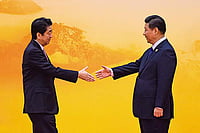“Fifty years ago, the Indian government was blinded by selfish interests, and wanted to force the Chinese to accept an illegal border line created by colonial powers,” wrote Hong Yuan of the Chinese Academy of Social Sciences in The Global Times on June 28 this year. “Today, both countries need to learn from their ancient friendly ties and the lesson from the war.” But what exactly is that lesson?
The Sino-Indian war of 1962 was not the longest or bloodiest conflict in either nation’s modern history. Yet, even now, it provides insights into their complex relationship. For much of the past century, the two countries have tried to define themselves within the region. It’s unsurprising that both China and India should seek a role in Asia: both are giants in terms of size and population. Yet, factors, including imperialism (Japanese as well as western) and Cold War dynamics, have prevented either from exercising influence to the extent that location and resources might suggest. True, 1962 has been the only moment when the two clashed directly, but it illustrates a much wider dynamic of engagement interspersed with mutual misunderstanding and mistrust. In 1924, when Tagore visited China, he faced hostile young Chinese intellectuals, who thought his solutions were insufficient for their country’s problems. Nine decades later, the relationship between India and China still combines respect, anxiety and mutual misunderstanding.
Not long before 1962, there was a more positive encounter between the two countries. During WW-II, after Pearl Harbor, Chiang Kai-shek’s Nationalist China was brought into the Allied fold. In February 1942, Chiang visited India and talked at length with Nehru and Gandhi, hoping the Congress would encourage participation in the fight against Japan. Chiang’s meeting with Gandhi was not very positive, but his meetings with Nehru were encouraging, for Chiang saw himself, like the Congress leader, as a secular anti-imperialist. While the Congress did not agree explicitly to support Indian participation in the war, India played a crucial role in the defence of China, not least because Chinese, Indian, British and US troops served together in the liberation of Burma in 1944. There are few reminders of that shared wartime experience today in common memory. (One of the few that comes to mind is the ‘Chungking’ laundry in central Calcutta, named after China’s wartime capital, connected to India via the Burma Hump.)
Following the victory over Japan in 1945, both countries started their long journey of self-discovery in a post-imperial age. India’s independence in 1947 was a crucial moment at the end of empire. But China had not one but two rebirths as a sovereign power with an Asian destiny. In 1945, China stood as one of Roosevelt’s “Four Policemen”, the only non-European power to sit at the top table of the UN (as it still is today). In 1949, the victory of Mao Tse-tung’s Communists over Chiang’s Nationalists was in effect a declaration of the arrival of the first Asian Communist superpower, one with a distinctly aggressive view of its mission. The 1950s saw an increasing competition between the two countries in their visions of Asia. Both projected a sense of wider mission, in the case of India as a rare secular democracy in the non-European world, and in China’s case, as a revolutionary power prepared to dispute the status quo, in rhetoric if not necessarily actual policy. The Bandung Conference of 1955 had suggested that there might be space for a bloc of newly independent countries that would stand aside from the West and the Soviet bloc. In 1962, China and India both wanted to define themselves against the ideological partnerships that would have seemed most natural: India as a liberal democracy that nonetheless did not embrace the West, and China as a Communist state that rejected the USSR.
So, the confrontation in 1962 came at a time of identity crisis for both countries. For Nehru, who believed India and China might come together as heralds of a new anti-imperialist world, the clash was a rude shock, and India’s defeat a ruder one. Yet the clash also came at a bad time for the Chinese. The split with the USSR in 1960 had put relations with Moscow in the deep freeze, and relations with the US were still icy. The war coincided with a moment when the Cuban Missile Crisis was threatening to turn regional confrontation into global conflict. Having driven the Indians back, the Chinese army made little attempt to push their position further.
Nor did Mao make the war the basis of one of the major campaigns that marked his reign. The soul-searching felt among India’s elites after the defeat was not matched by parallel discussions in China. Yet there were geopolitical consequences, not least the strengthening of China’s relationship with Pakistan. And this in turn would also lead toward the opening of relations with America a decade later.
The war is not widely remembered in China today. True, in September this year the Chinese Academy of Social Sciences brought together scholars to discuss the legacy of the clash. But the dispute does not animate the Chinese public. This should be a source of relief rather than resentment. The memories of the devastating war between China and Japan from 1937 to 1945 continue to colour relations between those two countries even today, as the student protests against Japan in Chinese cities this summer have shown. In contrast, the likelihood of demonstrations against India is vanishingly small. New Delhi does not provoke existential fears in Beijing the way that Washington or even Tokyo does.
In India, in contrast, there is still major interest in the legacy of a war that remains the only time the independent nation has been defeated in battle. The 50th anniversary comes at a time when there are increasing fears of encirclement by powers aligned toward China (‘the string of pearls’). The implication is of a linear trajectory of Chinese aggression across time from 1962 to the present. The fact that the legacy of the war matters so much in India, and relatively little in China, may at first seem to suggest a more mature attitude on China’s part. But actually it is something of a tribute to India. The war also came during the momentous days of the Great Leap Forward, which killed over 20 million people, and just before the horrors of the Cultural Revolution. It is unsurprising that a relatively small conflict in an under-inhabited corner failed to find a wider public resonance. Indian politics were hardly calm in the 1960s, but at the same time there was nothing that rivalled the devastation of the same period in China.
Now, in the early twenty-first century, India and China both seek to raise their status in Asia. Both countries do so with caution. China is feared by many in the region, who see its military build-up and opaque politics and fear that its self-description as a “responsible power” is a cover for more aggressive ambitions. India, in contrast, suffers more of an existential crisis, seeking to define its role in Asia while aware that its influence runs less wide in the region than that of Beijing. The ‘lesson’ of 1962 may be that there are still two different visions of Asia, and that while a repetition of the conflict of half a century ago seems unthinkable, the two sides are still a long way from a meeting of minds about the way the region will look in future.
(Rana Mitter is professor of the history and politics of modern China at the University of Oxford)

























